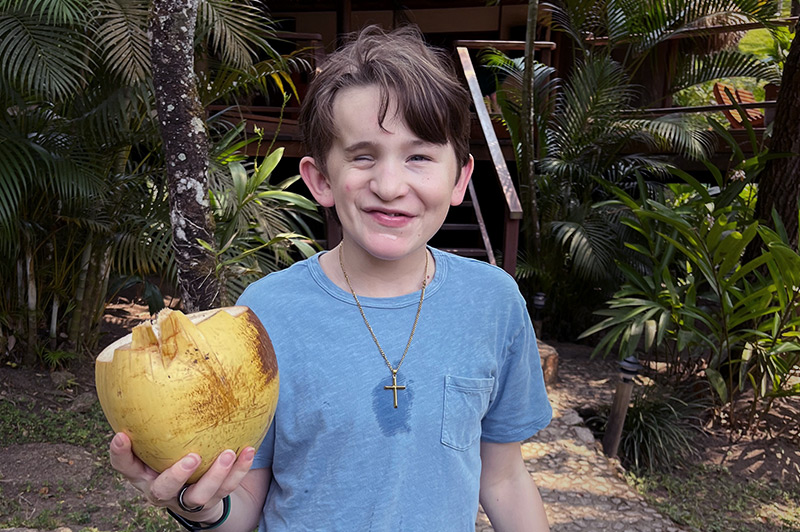Defying the odds: Cruise’s triumph against cavernous malformations and debilitating headaches

As a toddler, Cruise — now 13 — faced a rare cancer diagnosis that came with an 11 percent chance of survival. But with his trademark resilience and strength of spirit, Cruise defied the daunting odds and beat his cancer. The battle left its mark though — in the form of cavernous malformations in his brain. Cavernous malformations are abnormal clusters of blood vessels that can grow and press on surrounding tissue or organs, potentially causing symptoms such as headaches, seizures, or bleeding.
Following his cancer treatment, Cruise and his family lived with an insidious awareness of his cavernous malformations, hoping they’d remain dormant as most do. At the beginning of this year, however, one of the malformations began to grow, triggering debilitating headaches that eventually kept Cruise from living his everyday life.
“By February, he wasn’t going to school at all. He was at home in bed,” remembers Cruise’s mother, Jennifer. “He didn’t want to hang out with friends. He didn’t want to play sports; he didn’t want to ski. And this is my kid who was always out playing a sport with friends and loved going to school.”
A nationwide search for answers
As Cruise’s headaches persisted and imaging confirmed that the cavernous malformation was pressing on his motor cortex — the area of the brain that controls muscle movement — Jennifer and her husband, Drew, knew they had to take action. Finding the right team and treatment, however, proved to be a challenge.
They embarked from their home in Colorado on a nationwide tour to meet with physicians who had expertise in cavernous malformations, but few gave Jennifer and Drew the answers they needed. Specifically, they wanted to know if there was a treatment that could finally end Cruise’s headaches.
“We wanted someone who had been there hundreds and hundreds of times and seen every possible scenario,” says Jennifer. “We went full court press to find doctors who had that level of experience with cavernous malformations.”
When they met with Dr. Ed Smith, co-director of the Cerebrovascular Surgery and Interventions Center at Boston Children’s Hospital (CSIC), Jennifer had a good feeling. The Center had been designated by the Alliance to Cure Cavernous Malformation as its first pediatric Center of Excellence due in part to its having the highest volume of patients.
“When we met with Dr. Smith, he was able to answer all our questions. And he was almost answering our questions before we even asked them,” says Jennifer. “It was just enormous for us to have someone who had the statistics, the reasoning, the knowledge, and the information that allowed me to sleep solidly for the first time in months.”
Making informed decisions about and during surgery
As the family considered their options, two concepts stood out: The CSIC team would use a specialized MRI to provide critical insights about Cruise’s brain when planning his surgery, ensuring the safest path through his motor cortex and minimizing the risk of injury. The team would also perform an MRI during Cruise’s operation to confirm that Dr. Smith had removed the entire cluster of vessels.
“That was something that nobody had suggested or proposed until we got to Dr. Smith,” says Jennifer.
With Cruise as the key decision-maker, the family decided to move forward with surgical removal of his cavernous malformation.
Freedom from pain and a return to normal
Cruise underwent surgery in late April.

He emerged from the procedure with no signs of paralysis and — for the first time in months — no headache.
“I don’t know how to describe it,” says Cruise. “Having had a headache for three or four months and then waking up and there were no more — it felt so nice I could cry.”
Today, he’s back to all his favorite things, including basketball, soccer, skiing, biking, and lacrosse.
“This kid has always been a rock star,” says Jennifer. “It was so hard to see him suffering and not moving through life in his usual way, so to have him say he feels good and is out of pain, I couldn’t ask for a bigger gift.”
Learn more about the Cerebrovascular Surgery and Interventions Center at Boston Children’s Hospital or request an appointment.
Related Posts :
-

Chronic headaches: Five things families should know
You might think of headaches as an adult problem, but they can affect children and teens, too. In fact, about 20 ...
-

Like father, like daughter: Finding care for cavernous malformations
After Charlotte Miller underwent neurosurgery, her parents, Daniel and Eliza were a little nervous to tell her that part of ...
-

Sharing our journey with cavernous malformations
Finley and her twin sister, Rowan, were born seven weeks premature on November 7, 2017 in Scranton, Pennsylvania. In July 2019, Finley was ...
-

Thinking – and operating – outside the box: Bypassing Saoirse’s aneurysm
Saoirse just turned 3. There was a big to-do for her birthday, complete with family flying to Massachusetts from Ireland for ...





